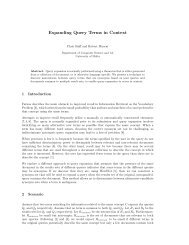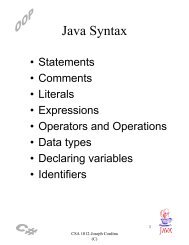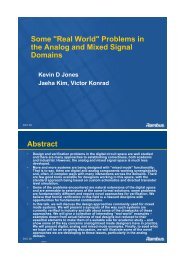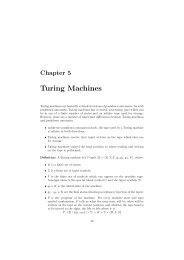Proceedings of CSAW'04 - FTP Directory Listing - University of Malta
Proceedings of CSAW'04 - FTP Directory Listing - University of Malta
Proceedings of CSAW'04 - FTP Directory Listing - University of Malta
You also want an ePaper? Increase the reach of your titles
YUMPU automatically turns print PDFs into web optimized ePapers that Google loves.
Simulo Tempestas: A Simulation Tool for Hydrological Modelling 13<br />
Fig. 1. The layering in Simulo Tempestas<br />
Roughness Index Layer It was mentioned earlier on that our flow model will simulate the flow<br />
<strong>of</strong> water against time. A semi-empirical formula called Manning’s Equation is adopted for such<br />
flow-rate prediction and is described later on in this synopsis. The so called Manning constant, is<br />
used in conjunction with other geo-morphological values, derived from the terrain data, to be able<br />
to calculate such water velocities. This Manning constant is what is being called in this system the<br />
Roughness Index. Allowing different areas on the ground to be assigned a roughness index enables<br />
better modelling <strong>of</strong> flow. To cite a small example, it can be said that a cemented surface allows<br />
better flow <strong>of</strong> water than a rocky and weedy surface. This index helps identify such features on the<br />
terrain.<br />
Location Layer This layer serves the purpose <strong>of</strong> partitioning the terrain into indexed, logical<br />
partitions. Partitioning helps us understand and assimilate the results better since humans, by<br />
nature, give names to regions and places so that they are identifiable. The user might want to<br />
collect results from the tool using some particular scheme such as dividing the Maltese terrain by<br />
region e.g. North, South and Central or by locality e.g Attard, Birkirkara, Balzan.<br />
Climate Layer The last and top most layer in our system, is as important as the rest. Ultimately,<br />
to be able to run a simulation something is needed to generate precipitation over the terrain. This<br />
layer consists <strong>of</strong> virtual clouds and wind which, as seen later on, are responsible for providing the<br />
data to our hydrological model.<br />
3 Simulation Engine<br />
Apart from performing the actual modelling, the simulation engine is also responsible for preparing<br />
and populating the necessary data structures that will be used during the simulation. These populated<br />
structures will be used throughout the entire simulation process many times over and have<br />
been meticulously designed and optimised to increase the efficiency <strong>of</strong> the simulation. Increasing<br />
the efficiency meant finding a balance between processor and memory usage.<br />
The simulation process involves the triggering <strong>of</strong> appropriate events in an orderly fashion for a<br />
number <strong>of</strong> cycles. In one cycle <strong>of</strong> the simulation process, referred to as a Tick, the model is evolved<br />
by integrating the new input with the results <strong>of</strong> the previous cycle to produce another set <strong>of</strong> results.<br />
These in turn will be used again as input in the next cycle. Since the modelling is performed against<br />
time and our simulation engine works in a discrete manner, one cycle <strong>of</strong> events must represent some<br />
fixed amount <strong>of</strong> time. Having a cycle represent a small amount <strong>of</strong> time means that the simulation













